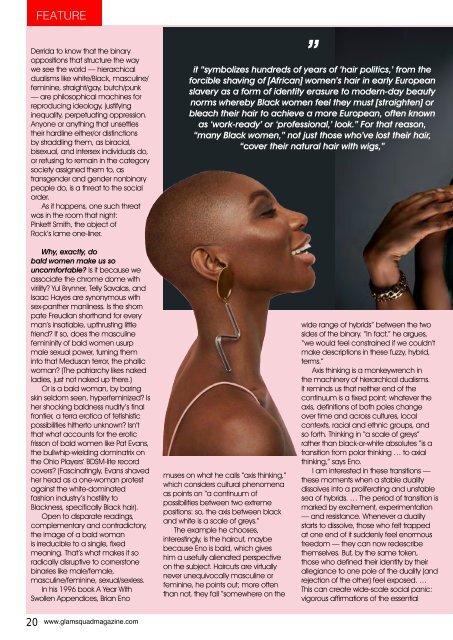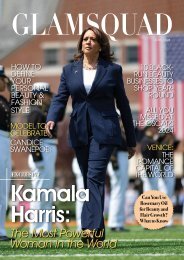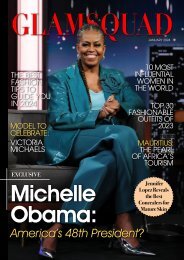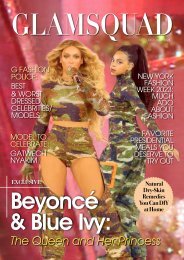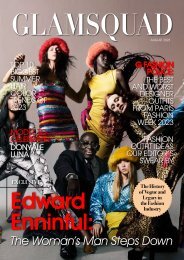Glamsquad magazine april-may 2022
You also want an ePaper? Increase the reach of your titles
YUMPU automatically turns print PDFs into web optimized ePapers that Google loves.
FEATURE<br />
Derrida to know that the binary<br />
oppositions that structure the way<br />
we see the world — hierarchical<br />
dualisms like white/Black, masculine/<br />
feminine, straight/gay, butch/punk<br />
— are philosophical machines for<br />
reproducing ideology, justifying<br />
inequality, perpetuating oppression.<br />
Anyone or anything that unsettles<br />
their hardline either/or distinctions<br />
by straddling them, as biracial,<br />
bisexual, and intersex individuals do,<br />
or refusing to remain in the category<br />
society assigned them to, as<br />
transgender and gender nonbinary<br />
people do, is a threat to the social<br />
order.<br />
As it happens, one such threat<br />
was in the room that night:<br />
Pinkett Smith, the object of<br />
Rock’s lame one-liner.<br />
”<br />
it “symbolizes hundreds of years of ‘hair politics,’ from the<br />
forcible shaving of [African] women’s hair in early European<br />
slavery as a form of identity erasure to modern-day beauty<br />
norms whereby Black women feel they must [straighten] or<br />
bleach their hair to achieve a more European, often known<br />
as ‘work-ready’ or ‘professional,’ look.” For that reason,<br />
“many Black women,” not just those who’ve lost their hair,<br />
“cover their natural hair with wigs,”<br />
Why, exactly, do<br />
bald women make us so<br />
uncomfortable? Is it because we<br />
associate the chrome dome with<br />
virility? Yul Brynner, Telly Savalas, and<br />
Isaac Hayes are synonymous with<br />
sex-panther manliness. Is the shorn<br />
pate Freudian shorthand for every<br />
man’s insatiable, upthrusting little<br />
friend? If so, does the masculine<br />
femininity of bald women usurp<br />
male sexual power, turning them<br />
into that Medusan terror, the phallic<br />
woman? (The patriarchy likes naked<br />
ladies, just not naked up there.)<br />
Or is a bald woman, by baring<br />
skin seldom seen, hyperfeminized? Is<br />
her shocking baldness nudity’s final<br />
frontier, a terra erotica of fetishistic<br />
possibilities hitherto unknown? Isn’t<br />
that what accounts for the erotic<br />
frisson of bald women like Pat Evans,<br />
the bullwhip-wielding dominatrix on<br />
the Ohio Players’ BDSM-lite record<br />
covers? (Fascinatingly, Evans shaved<br />
her head as a one-woman protest<br />
against the white-dominated<br />
fashion industry’s hostility to<br />
Blackness, specifically Black hair).<br />
Open to disparate readings,<br />
complementary and contradictory,<br />
the image of a bald woman<br />
is irreducible to a single, fixed<br />
meaning. That’s what makes it so<br />
radically disruptive to cornerstone<br />
binaries like male/female,<br />
masculine/feminine, sexual/sexless.<br />
In his 1996 book A Year With<br />
Swollen Appendices, Brian Eno<br />
muses on what he calls “axis thinking,”<br />
which considers cultural phenomena<br />
as points on “a continuum of<br />
possibilities between two extreme<br />
positions: so, the axis between black<br />
and white is a scale of greys.”<br />
The example he chooses,<br />
interestingly, is the haircut, <strong>may</strong>be<br />
because Eno is bald, which gives<br />
him a usefully alienated perspective<br />
on the subject. Haircuts are virtually<br />
never unequivocally masculine or<br />
feminine, he points out; more often<br />
than not, they fall “somewhere on the<br />
wide range of hybrids” between the two<br />
sides of the binary. “In fact,” he argues,<br />
“we would feel constrained if we couldn’t<br />
make descriptions in these fuzzy, hybrid,<br />
terms.”<br />
Axis thinking is a monkeywrench in<br />
the machinery of hierarchical dualisms.<br />
It reminds us that neither end of the<br />
continuum is a fixed point; whatever the<br />
axis, definitions of both poles change<br />
over time and across cultures, local<br />
contexts, racial and ethnic groups, and<br />
so forth. Thinking in “a scale of greys”<br />
rather than black-or-white absolutes “is a<br />
transition from polar thinking … to axial<br />
thinking,” says Eno.<br />
I am interested in these transitions —<br />
these moments when a stable duality<br />
dissolves into a proliferating and unstable<br />
sea of hybrids. … The period of transition is<br />
marked by excitement, experimentation<br />
— and resistance. Whenever a duality<br />
starts to dissolve, those who felt trapped<br />
at one end of it suddenly feel enormous<br />
freedom — they can now redescribe<br />
themselves. But, by the same token,<br />
those who defined their identity by their<br />
allegiance to one pole of the duality (and<br />
rejection of the other) feel exposed. …<br />
This can create wide-scale social panic:<br />
vigorous affirmations of the essential<br />
20<br />
www.glamsquad<strong>magazine</strong>.com


